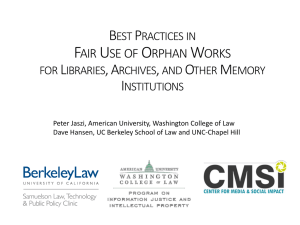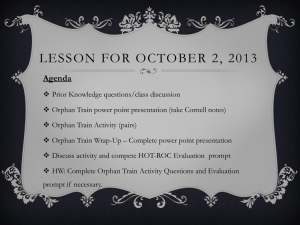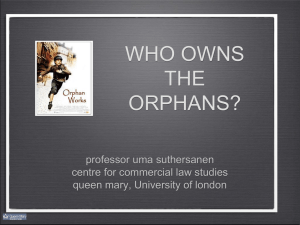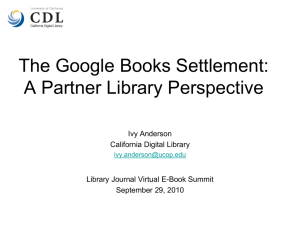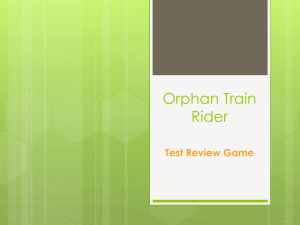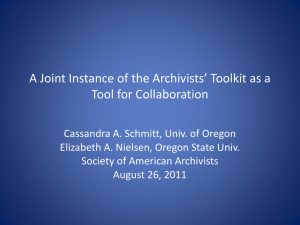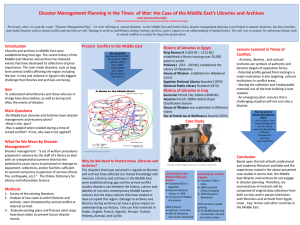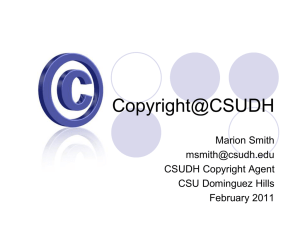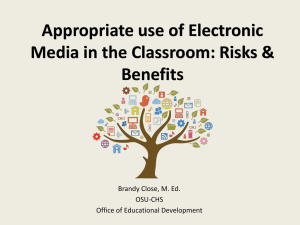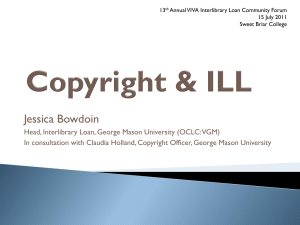Slides
advertisement
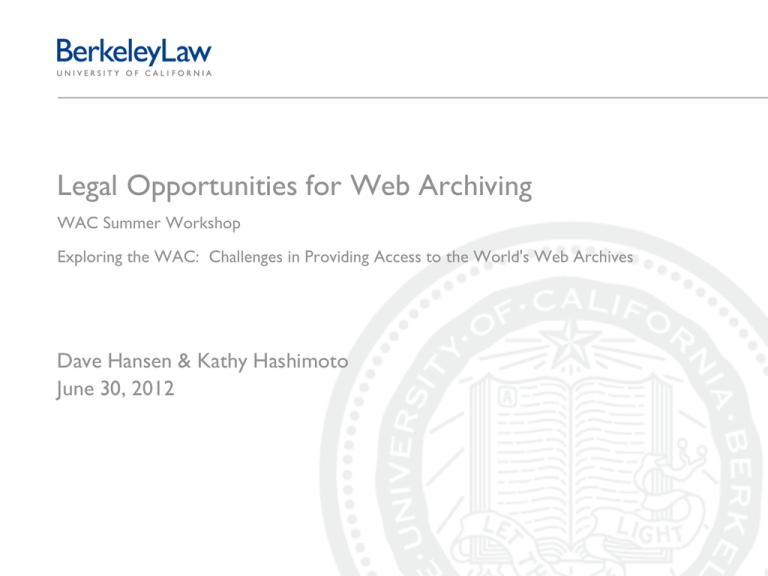
Legal Opportunities for Web Archiving WAC Summer Workshop Exploring the WAC: Challenges in Providing Access to the World's Web Archives Dave Hansen & Kathy Hashimoto June 30, 2012 Berkeley Digital Library Copyright Project Goal: “to investigate copyright obstacles faced by libraries and other like-minded organizations in their efforts to realize the full potential of present and future digital library initiatives. Our efforts are concentrated on both the obstacles themselves and the range of possible legal, technological, social, and market-based solutions to overcome them.” Issues: • orphan works • library privileges • digital lending • metadata ownership http://www.law.berkeley.edu/12040.htm “An open, distributed network of comprehensive online resources that would draw on the nation’s living heritage from libraries, universities, archives, and museums in order to educate, inform and empower everyone in the current and future generations.” http://dp.la Orphan Works Problem: “the situation where the owner of a copyrighted work cannot be identified and located by someone who wishes to make use of the work in a manner that requires permission of the copyright owner.” -- REGISTER OF COPYRIGHTS, REPORT ON ORPHAN WORKS (2006). Solutions include: • Fair Use • Legislation (2006-2008 proposals before Congress) • Extended Collective Licensing http://www.law.berkeley.edu/orphanworks.htm Structure of Copyright Exclusive rights of owner (§ 106) • • • • • • Reproduce Prepare derivative works Distribute to public Perform publicly Display publicly For sound recordings, perform over digital network Limitations on exclusive rights • • • • • § 107 – Fair use § 108 – For Libraries and Archives § 109 – “First sale” § 110 – Non-profit Performances §§ 111-122 – further refinement Title 17, United States Code: http://www.law.cornell.edu/uscode/text/17/ For Library & Archives § 108 (a) - Qualifying libraries & archives: • Reproduction or distribution is made without any purpose of direct or indirect commercial advantage; • Collections open to public (or available to any specialized researchers in the field) • Includes notice about copyright For Library & Archives § 108 (a) - Qualifying libraries & archives: “a purely commercial enterprise could not establish a collection of copyrighted works, call itself a library or archive, and engage in for-profit reproduction and distribution of photocopies.” H.R. REP. NO. 94-1476, at 74 (1976). “the term ‘libraries’ and ‘archives’ as used and described in this provision still refer to such institutions only in the conventional sense of entities that are established as, and conduct their operations through, physical premises in which collections of information may be used by researchers and other members of the public.” S. REP. NO. 105-190, at 62 (1998). For Library & Archives Preservation: • 108(b) – right to reproduce/distribute three copies of unpublished works solely for preservation, etc., • 108(c) – right to reproduce/distribute three copies of published works if: •Work is damaged, deteriorating, lost, or stolen, or if the existing format in which the work is stored has become obsolete* if: • Cannot obtain unused copy at “fair price” Updating preservation for digital age: “any such copy . . . in digital format is not made available to the public in that format outside the premises of the library or archives” * “obsolete” means reader/device is no longer manufactured or reasonably available in commercial market place For Library & Archives Lending: • 108(d): upon user request, can make reproduction of “no more than one article or other contribution to a copyrighted collection or periodical issue, or to a copy or phonorecord of a small part of any other copyrighted work” • 108(e): upon user request, copy of entire work if “the library or archives has first determined, on the basis of a reasonable investigation, that a copy or phonorecord of the copyrighted work cannot be obtained at a fair price” • Both conditioned on • Copy becomes property of user and there is a lack of knowledge that the copy will be used for anything but scholarship, personal use, etc., • Notice about (c) protection More Limits… 108(i): The rights of reproduction and distribution under this section do not apply to a musical work, a pictorial, graphic or sculptural work, or a motion picture or other audiovisual work other than an audiovisual work dealing with news, 108(g): The rights of reproduction and distribution under this section extend to the isolated and unrelated reproduction or distribution of a single copy or phonorecord of the same material on separate occasions, but do not extend to cases where the library or archives, or its employee - (1) is aware or has substantial reason to believe that it is engaging in the related or concerted reproduction or distribution of multiple copies or . . . engages in the systematic reproduction. For Library & Archives Efforts to update section 108 for libraries and archives 2008: Section 108 Study Group Group conclusions “Currently there are very few examples of virtual-only libraries and archives that meet the existing and recommended criteria for section 108 eligibility. The Study Group discussed, but did not agree on, whether it is premature to determine if virtual-only libraries and archives should be covered by section 108.” Suggestions for change A new exception should be added to section 108 to permit libraries and archives to capture and reproduce publicly available online content for preservation purposes, and to make those copies accessible to users for purposes of private study, scholarship, or research. Orphan Works on the Internet Orphan Works Problem: “the situation where the owner of a copyrighted work cannot be identified and located by someone who wishes to make use of the work in a manner that requires permission of the copyright owner.” -- REGISTER OF COPYRIGHTS, REPORT ON ORPHAN WORKS (2006). Orphan Works on the Internet Why do we have an orphan works problem? • Explosion in number of works • Copyright duration is very long • Almost any work qualifies for copyright protection automatically + • Rights clearance impossible = Risk of liability (high statutory damages) Thomas Kennington (1885) Orphan Works on the Internet Proposed solutions • U.S. legislation (2005, 2008) • EU directive (in progress) • Licensing regime • Canada • ECL • Fair use Orphan Works on the Internet “How Fair Use Can Help Solve the Orphan Works Problem” Jennifer Urban, U.C. Berkeley School of Law BERKELEY TECHNOLOGY LAW JOURNAL (forthcoming 2012) http://papers.ssrn.com/sol3/papers.cfm?abstract_id=2089526 Orphan Works on the Internet Fair Use • Foundational to U.S. copyright system • Fair use operates as an “equitable rule of reason” • Factors are interrelated, and must be read as such (Campbell) 19 Orphan Works on the Internet Fair Use 17 U.S.C. 107 [F]air use of a copyrighted work... for purposes such as criticism, comment, news reporting, teaching (including multiple copies for classroom use), scholarship, or research, is not an infringement of copyright. …the factors to be considered shall include— (1) the purpose and character of the use, including whether such use is of a commercial nature or is for nonprofit educational purposes; (2) the nature of the copyrighted work; (3) the amount and substantiality of the portion used in relation to the copyrighted work as a whole; and (4) the effect of the use upon the potential market for or value of the copyrighted work. The fact that a work is unpublished shall not itself bar a finding of fair use if such finding is made upon consideration of all the above factors. Orphan Works on the Internet Fair Use factor #2: The nature of the copyrighted work • Historically underused, tends not to drive fair use decisions • But: the 2nd factor should play an important role in orphan works cases • Two aspects of a work’s nature are traditionally considered (Beebe) • Is it more factual, or more creative? • Is it published, or unpublished? • Courts also sometimes consider the availability of the work (e.g., in print, or out of print) Orphan Works on the Internet Fair Use factor #2: The nature of the copyrighted work Additional considerations should apply in the case of orphan works: • Work’s nature can illuminate incentive to create the work in the first place • Many incentives to create are unlikely to be injured by allowing fair use • Economic vs. noneconomic incentive • Examples • • • • Scholarly works Home movies and amateur snapshots Advertising copy and meeting minutes Letters, brochures Orphan Works on the Internet Fair Use factor #4: Effect on the market for the ©’d work • Traditionally one of the more important factors • “Market failure” concept • In orphan works situations, where one party is necessarily absent to conduct a negotiation market failure • Hard to harm a market that does not exist • Importance of search Orphan Works on the Internet Fair Use factor #1: Purpose and character of the use • Traditionally one of the most important factors and first to be considered • Asks: • Does the use further core societal goals • Or does it simply interfere with the rights of the owner to exploit his/her work? 24 Orphan Works on the Internet Fair Use 17 U.S.C. 107 [F]air use of a copyrighted work... for purposes such as criticism, comment, news reporting, teaching (including multiple copies for classroom use), scholarship, or research, is not an infringement of copyright. …the factors to be considered shall include— (1) the purpose and character of the use, including whether such use is of a commercial nature or is for nonprofit educational purposes; (2) the nature of the copyrighted work; (3) the amount and substantiality of the portion used in relation to the copyrighted work as a whole; and (4) the effect of the use upon the potential market for or value of the copyrighted work. The fact that a work is unpublished shall not itself bar a finding of fair use if such finding is made upon consideration of all the above factors. Orphan Works on the Internet Fair Use factor #1: Purpose and character of the use • Arguably favors many library and archive functions • Preventing loss of cultural resources for future generations • Orphan works are at particular risk of being lost • Curation, organizing, indexing adds to entire collection • Libraries, archives, and other nonprofits support a variety of learning and access goals for a wide variety of patrons Orphan Works on the Internet Fair Use factor #3: Amount and substantiality of the use • Courts engage in quantitative and qualitative analysis • In past, using an entire work weighed against fair use • Modern trend: courts ask whether amount is reasonable in light of the use • Use of whole works justified in variety of situations (Sony, Kelly, Perfect 10) • For goals such as preservation, access to information and scholarship, using the entire work is often necessary Orphan Works on the Internet Other considerations • Good faith record-keeping of searches • Giving public notice and offering an “opt out” if an owner appears • Limiting uses to noncommercial, educational uses • Taking down or licensing a work if an owner appears and a licensing market develops Orphan Works on the Internet In conclusion and caveat • This is not to say that fair use absolutely applies and reduces risk! • Noncommercial, socially beneficial purposes help in any fair use inquiry • In addition, a work’s orphan status can be an important consideration • Consider carefully and develop good policy/practices to support decisions Non-expressive Uses of Copyrighted Works Copyright protects works of authorship, not facts Copyright protects expression, not ideas “In no case does copyright protection for an original work of authorship extend to any idea, procedure, process, system, method of operation, concept, principle, or discovery, regardless of the form in which it is described, explained, illustrated, or embodied in such work.” 17 U.S.C 102(b). Matt Sag, Orphan Works as Grist for the Data Mill (forthcoming 2012). Authors Guild v. Google Authors Guild v. HathiTrust Moby Dick Non-expressive Uses of Copyrighted Works “Moby Dick” word cloud (common English words excluded) “Weird Song You Cute” Youtube Comments / e-book word cloud The use of non-expressive elements is not infringing
